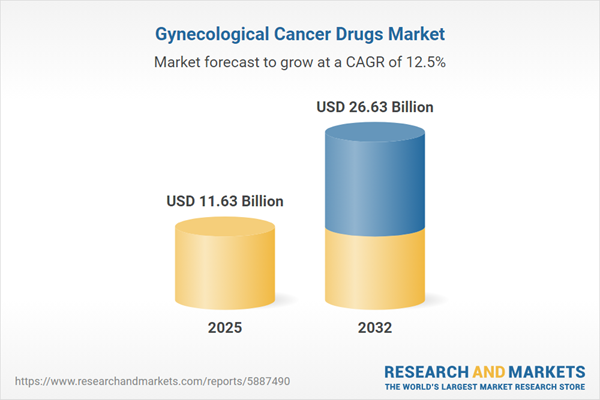Speak directly to the analyst to clarify any post sales queries you may have.
Senior decision-makers navigating the gynecological cancer drugs market encounter a rapidly evolving environment shaped by clinical innovation, regulatory shifts, and technological transformation. Building organizational resilience and seizing growth opportunities relies on data-driven resource allocation, agile market strategies, and proactive investment.
Market Snapshot: Gynecological Cancer Drugs Market
The global gynecological cancer drugs market demonstrates significant expansion in 2024, valued at USD 10.35 billion and projected to reach USD 11.63 billion by 2025. Supported by a robust compound annual growth rate (CAGR) of 12.53%, forecasts indicate the market will attain USD 26.63 billion by 2032. Demand is propelled by intensified research and development, increased precision oncology integration, and heightened need for novel therapeutics. Evolving population demographics and patient-centered care models are prompting stakeholders to extend operational footprints. Digital health technologies and optimized supply chain planning are increasing access, especially in underserved geographies. Ongoing technology adoption and strategic investments in regional healthcare delivery continue to influence the trajectory of the gynecological cancer drugs market.
Scope & Segmentation of the Gynecological Cancer Drugs Market
- End User: Oncology clinics, outpatient facilities, specialty centers, and both public and private hospitals enable rapid integration of advanced treatments, offering adaptable approaches to changing care requirements and protocols. Each setting contributes to increased treatment adoption and improved patient management.
- Distribution Channel: Hospital pharmacies, retail pharmacies, and online platforms collaborate to provide reliable and efficient medication access, with online channels overcoming geographical barriers and improving service in remote or resource-limited areas.
- Administration Route: Providers select intraperitoneal, intravenous, or oral administration to optimize therapy delivery, align resource utilization, and address diverse patient care pathways within existing infrastructure.
- Drug Class: The portfolio spans traditional chemotherapy agents (alkylating agents, platinum-based compounds, taxanes), hormonal therapies, immunotherapies (e.g., checkpoint inhibitors, vaccines), and targeted treatments such as PARP inhibitors and angiogenesis inhibitors, supporting continuous advancement in clinical outcomes.
- Cancer Type: Solutions address cervical, endometrial, ovarian, and vulvar cancers. This range allows systems to design care models, allocate resources effectively, and respond to local disease prevalence and clinical priorities.
- Geography: The market sees participation across North America, South America, Europe, Middle East, Africa, and Asia-Pacific. Influential countries include the United States, Germany, China, India, Brazil, Saudi Arabia, Canada, and South Africa, with regulatory environments and investment strategies shaping regional market development and technology integration.
- Key Players: Market progress is driven by F. Hoffmann-La Roche Ltd, AstraZeneca PLC, Merck & Co., Inc., GlaxoSmithKline plc, Clovis Oncology, Inc., Pfizer Inc., Novartis AG, Johnson & Johnson, Eisai Co., Ltd, and Amgen Inc., all actively advancing drug pipelines and strategic collaborations.
Key Takeaways for Senior Decision-Makers
- Precision oncology supports segmentation of patient populations, enabling more targeted resource use and consistent improvements in care quality.
- Collaborative relationships among pharmaceutical companies, biotechnology firms, research organizations, and contract research organizations accelerate drug development and strengthen global market access.
- Staying aligned with regulatory developments and adjusting investment strategies to new payment models are vital for maintaining competitive advantage and market compliance.
- Expansion of digital health and online pharmacy presence increases patient engagement, facilitates efficient therapy access, and supports unique care needs, particularly in regions with limited clinical infrastructure.
- Customized strategies reflecting local healthcare system features allow organizations to navigate complex market environments and establish long-term operational advantages.
- Utilization of real-world data and adaptive clinical trial methods enables ongoing adjustment of protocols and more accurate identification of emerging trends in patient care and market demand.
Tariff Impact: Navigating US Tariff Adjustments in Oncology Drug Supply Chains
Recent US tariff changes introduce additional layers of complexity for supply chain management in oncology drugs. Manufacturers are strengthening resilience through supplier diversification and regional production expansion, while healthcare providers and payers are implementing risk-sharing models and refined inventory strategies. These actions aim to maintain efficient gynecological cancer drug access and stability, safeguarding against potential disruptions from shifting global trade dynamics.
Methodology & Data Sources
This report is informed by direct engagement with oncologists, regulatory specialists, and supply chain experts. Comprehensive secondary research, advanced market modeling, and thematic analysis underpin actionable insights for stakeholders evaluating the gynecological cancer drugs market.
Gynecological Cancer Drugs Market: Why This Report Matters
- Provides the benchmarks needed for effective portfolio management, while highlighting new strategic opportunities and potential areas for diversification as trends evolve.
- Clarifies how tariff adjustments and new service delivery models affect supply chain reliability, helping leaders prioritize risk management and continuity planning.
- Delivers critical guidance for aligning compliance, digital transformation efforts, and investment decisions with evolving market expectations and operational demands.
Conclusion
Senior executives will find in this report the intelligence required to address business risks, manage disruptions, and capture opportunities across the changing gynecological cancer drugs landscape.
Additional Product Information:
- Purchase of this report includes 1 year online access with quarterly updates.
- This report can be updated on request. Please contact our Customer Experience team using the Ask a Question widget on our website.
Table of Contents
3. Executive Summary
4. Market Overview
7. Cumulative Impact of Artificial Intelligence 2025
Companies Mentioned
The companies profiled in this Gynecological Cancer Drugs market report include:- F. Hoffmann-La Roche Ltd
- AstraZeneca PLC
- Merck & Co., Inc.
- GlaxoSmithKline PLC
- Clovis Oncology, Inc.
- Pfizer Inc.
- Novartis AG
- Johnson & Johnson
- Eisai Co., Ltd
- Amgen Inc.
Table Information
| Report Attribute | Details |
|---|---|
| No. of Pages | 187 |
| Published | November 2025 |
| Forecast Period | 2025 - 2032 |
| Estimated Market Value ( USD | $ 11.63 Billion |
| Forecasted Market Value ( USD | $ 26.63 Billion |
| Compound Annual Growth Rate | 12.5% |
| Regions Covered | Global |
| No. of Companies Mentioned | 11 |









